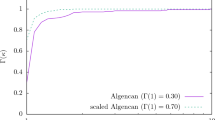Abstract
In this work, we propose a predictor–corrector interior point method for linear programming in a primal–dual context, where the next iterate is chosen by the minimization of a polynomial merit function of three variables: the first is the steplength, the second defines the central path and the third models the weight of a corrector direction. The merit function minimization is performed by restricting it to constraints defined by a neighborhood of the central path that allows wide steps. In this framework, we combine different directions, such as the predictor, the corrector and the centering directions, with the aim of producing a better one. The proposed method generalizes most of predictor–corrector interior point methods, depending on the choice of the variables described above. Convergence analysis of the method is carried out, considering an initial point that has a good practical performance, which results in Q-linear convergence of the iterates with polynomial complexity. Numerical experiments using the Netlib test set are made, which show that this approach is competitive when compared to well established solvers, such as PCx.

Similar content being viewed by others
References
Berti, L.F., Oliveira, A.R.L., Ghidini, C.T.L.S.: A variation on the interior point method for linear programming using the continued iteration. Math. Methods Oper. Res. 85(1), 1–15 (2016)
Colombo, M., Gondzio, J.: Further development of multiple centrality correctors for interior point methods. Comput. Optim. Appl. 41(3), 277–305 (2008)
Czyzyk, J., Mehrotra, S., Wagner, M., Wright, S.J.: PCx: an interior-point code for linear programming. Optim. Methods Softw. 11(1), 397–430 (1999)
Gondzio, J.: Multiple centrality corrections in a primal-dual method for linear programming. Comput. Optim. Appl. 6(2), 137–156 (1996)
Gondzio, J.: Interior point methods 25 years later. Eur. J. Oper. Res. 218(3), 587–601 (2012)
Herbison-Evans, D.: Solving quartics and cubics for graphics. In: Paeth, A.W. (ed.) Graphics Gems V, pp. 3–15. Academic, Boston (1995)
Jarre, F., Wechs, M.: Extending Mehrotra’s corrector for linear programs. Adv. Model. Optim. 1(2), 38–60 (1999)
Kojima, M., Mizuno, S.: A primal-dual infeasible-interior-point algorithm for linear programming. Math. Program. 61(3), 263–280 (1993)
Lasserre, J.B.: Global optimization with polynomials and the problem of moments. SIAM J. Optim. 11(3), 796–817 (2001)
Mehrotra, S.: On the implementation of a primal-dual interior point method. SIAM J. Optim. 2(4), 575–601 (1992)
Mehrotra, S., Li, Z.: Convergence conditions and Krylov subspace-based corrections for primal-dual interior-point method. SIAM J. Optim. 15(3), 635–653 (2005)
Monteiro, R.D.C., Adler, I., Resende, M.G.C.: A polynomial-time primal-dual affine scaling algorithm for linear and convex quadratic programming and its power series extension. Math. Oper. Res. 15(2), 191–214 (1990)
Villas-Bôas, F.R., Perin, C.: Postponing the choice of penalty parameter and step length. Comput. Optim. Appl. 24(1), 63–81 (2003)
Wright, S.J.: An infeasible-interior-point algorithm for linear complementarity problems. Math. Program. 67(1–3), 29–51 (1994)
Wright, S.J.: Primal-dual interior point methods, 1st edn. SIAM, Philadelphia (1997)
Wright, S.J., Zhang, Y.: A superquadratic infeasible-interior-point method for linear complementarity problems. Math. Program. 73(3), 269–289 (1996)
Zhang, Y.: On the convergence of a class of infeasible interior-point methods for the horizontal linear complementarity problem. SIAM J. Optim. 4(1), 208–227 (1994)
Zhang, Y., Zhang, D.: Superlinear convergence of infeasible-interior-point methods for linear programming. Math. Program. 66(1–3), 361–377 (1994)
Zhang, Y., Zhang, D.: On polynomiality of the Mehrotra-type predictor-corrector interior-point algorithms. Math. Program. 68(3), 303–318 (1995)
Acknowledgements
We thank the anonymous referees for their valuable suggestions that improved the presentation of this work.
Author information
Authors and Affiliations
Corresponding author
Additional information
Publisher's Note
Springer Nature remains neutral with regard to jurisdictional claims in published maps and institutional affiliations.
This research was sponsored by Brazilian Agencies Fundação de Amparo à Pesquisa do Estado de São Paulo (FAPESP) (Grants 08/09685-8 and 10/06822-4) and Conselho Nacional de Desenvolvimento Científico e Tecnológico (CNPq).
Rights and permissions
About this article
Cite this article
Santos, LR., Villas-Bôas, F., Oliveira, A.R.L. et al. Optimized choice of parameters in interior-point methods for linear programming. Comput Optim Appl 73, 535–574 (2019). https://doi.org/10.1007/s10589-019-00079-9
Received:
Published:
Issue Date:
DOI: https://doi.org/10.1007/s10589-019-00079-9




